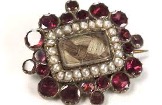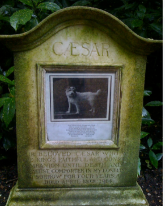Victorian Mourning Culture
Khaalilah Muhammad
Characterized by an era of industrialization, death was a recurring theme in Victorian Britain. The fascination with death stems, in fact, from their inability to escape it due to the Industrial Revolution’s high mortality rates (Victorian Mourning Culture). It became customary for families to go through elaborate rituals to commemorate the deceased. Due to the Victorian focus on realism and the ability of literature to capture everyday experience, writers began to explore the many aspects of the mourning experience. As a famous example, Tennyson’s In Memoriam captures the possibilities of grief, tracing the cycle of mourning across the span of three years. Michael Field, too, participated in this mourning culture with Whym Chow: Flame of Love. Whym Chow explores the intensity and significance of the human-animal relationship, during a time when animals were fast becoming part of the fabric of everyday life because, while the thoughts and attitudes towards mourning etiquette were rapidly changing, the Victorians also applied these grieving practices to their pets.
The popularization of mourning practices began with Queen Victoria (Mendoza). Famously, the sudden death of her husband, Prince Albert, caused her so much grief that it was felt around the world. Grieving her late husband became a central point of her everyday life, and for the next forty years her mourning rituals consisted of: dressing in black all of the time, having the servants set out Albert’s clothes and shaving supplies each day, cleaning his bedchamber and regularly changing his sheets (Hunter). As a result, England began to adopt elaborate (and quite unusual) mourning practices—death had become trendy, thanks to Queen Victoria.
Grief and mourning impacted all, and historians named this fascination with death “the Cult of Death” (Reeves). Whenever death occurred within a household, it affected every aspect of the family’s life. Those in mourning would express their grief in a number of ways: clothing, jewelry, portraits, and grave monuments honoring the deceased, as well as lavish funerals, among other rituals. While death itself was not a feared concept, not being properly mourned, was (Reeves). As a result, elaborate rituals—some still carried over today—were modeled after Queen Victoria’s practice, with the intention of reducing death’s impact on both the individual and society as a whole (Milner).
 Victorians turned mourning into an art form, allowing individuals to grieve, remember, and memorialize the deceased. In addition to the viewings of the body and the funeral itself, other trends in the “cult of death” included death photography and death jewelry, or memento mori (Reeves). Lesser-known practices included stopping the clocks in the home at the hour of death, famously depicted in Charles Dickens’s Bleak House, and covering all mirrors until after the funeral. In many ways, therefore, we can read Whym Chow as an artistic mourning ritual. Like memento mori, the Fields preserve their grief over the loss of their dog in a volume of poems covered in russet suede. Like a mourning brooch preserving the hair of the deceased, the volume itself preserves Whym’s memory, inviting the reader to materially experience the dog’s “fur” as they encounter the volume.[1]
Victorians turned mourning into an art form, allowing individuals to grieve, remember, and memorialize the deceased. In addition to the viewings of the body and the funeral itself, other trends in the “cult of death” included death photography and death jewelry, or memento mori (Reeves). Lesser-known practices included stopping the clocks in the home at the hour of death, famously depicted in Charles Dickens’s Bleak House, and covering all mirrors until after the funeral. In many ways, therefore, we can read Whym Chow as an artistic mourning ritual. Like memento mori, the Fields preserve their grief over the loss of their dog in a volume of poems covered in russet suede. Like a mourning brooch preserving the hair of the deceased, the volume itself preserves Whym’s memory, inviting the reader to materially experience the dog’s “fur” as they encounter the volume.[1]
Writing became a means of memorialization, with Elizabeth Barrett Browning and Alfred Lord Tennyson, among others, exploring the personal need for comfort during mourning. Notably, these attempts at writing about personal loss were directed towards humanity. What makes Whym Chow unique is its elegizing of an animal. While the Victorians developed mourning culture, the nineteenth-century public also saw an increased fascination with pets. Human beings  outwardly show affection and sympathy, and these emotions extended to animals. To do otherwise, as antivivisectionists of the period argued, would be inhumane. Therefore, as a “cult” arose around the death of human beings, individuals also began to properly mourn their animals. Because the human-animal relationship was perceived as meaningful, some pets were even given proper Christian burials, and their own cemeteries or shrines within the home—sometimes in the form of taxidermy. Though not a Christian rite, Michael Field, too, erected a Bacchic altar in their garden, and Whym Chow often sat at the foot at the altar (Knight 97). The dog, their “Bacchic cub” in life was memorialized in pagan-Christian ritual in death.
outwardly show affection and sympathy, and these emotions extended to animals. To do otherwise, as antivivisectionists of the period argued, would be inhumane. Therefore, as a “cult” arose around the death of human beings, individuals also began to properly mourn their animals. Because the human-animal relationship was perceived as meaningful, some pets were even given proper Christian burials, and their own cemeteries or shrines within the home—sometimes in the form of taxidermy. Though not a Christian rite, Michael Field, too, erected a Bacchic altar in their garden, and Whym Chow often sat at the foot at the altar (Knight 97). The dog, their “Bacchic cub” in life was memorialized in pagan-Christian ritual in death.
On January 28, 1906, the day they euthanized Whym Chow, Edith Cooper wrote in their journal:
Sunday—how terrible Sundays are! Milestones of doom to us as a family. Today I have had the worst loss of my life—yes, worse than that of my beloved Mother or the tragic father…My Whym Chow, my little Chow-Chow, my Flame of Love is dead & has died—O cruel God!—by our will! (qtd. in Thain and Vadillo, 281)
Cooper describes God as “cruel” for taking Chow away from them, but also expresses angst over their role in the death: “by our will.” It is a passage marked by loss—the loss of both mother and father—but this entry stands out because the “worst loss” is relegated to the dog. The human-animal relationship is obviously strong, demonstrated by the many epithets surrounding the well-loved possession: “My Whym Chow, my little Chow-Chow, my Flame of Love.” Moreover, in “Trinity,” Michael Field explore more fully their relationship with Whym, a relationship that is described as blasphemous. Jill Ehnenn argues that Whym Chow served as either “an erotic proxy for Bradley and Cooper’s same-sex love,” a way for them to combine “homoeroticism, religiosity and dog-love into a form of art” (Ehnenn)—which became a central part of their theological narrative(s), following Chow’s death.
Elegiac poetry uses imagery to relive moments, as a way to both process grief and honor the deceased. Memories in Whym Chow allude to his death, and, in particular, to his dead body, such as in “Semper Jam.” In other poems, such as “Requiescat” or “Absence,” the Fields remember Chow through his absence, or, as in Poem XXIV, “Loved Confessionals” in pleasant memories of the warmth of his fur, or, as in Poem XXV “I Want you, little Love,” the way he would scowl. It can be argued that the purpose of elegy is not only to help an individual process their grief, but to move past it, too.[2] But the Fields take these past memories and immortalize them in their poetry, which indicates their inability to be consoled over the death of Whym Chow. Despite being inconsolable, they hint in Poem XXII, “Sleeping Together,” at the idea of the Fields taking comfort in each other in order to heal from their grief.
Whym Chow: Flame of Love demonstrates how the Fields were able to take the culture of mourning and the inclusion of animals in nineteenth-century society, and transfer them into a volume that speaks to the strong bond the two shared with their pet, and the grief they experienced over losing him.
Works Cited
Ehnenn, Jill. “‘Drag (ging) at emory’s fetter’: Michael Field’s Personal Elegies, Victorian Mourning, and the Problem of Whym Chow.” The Michaelian, 1.1, 2009, http://www.thelatchkey.org/Field/MF1/ehnennarticle.htm. Accessed 5 May 2021.
Hunter, Lyn. “A Victorian Obsession With Death.” Berkeleyan, 5 Apr. 2000, www.berkeley.edu/news/berkeleyan/2000/04/05/death.html. Accessed 5 May 2021.
Knight, Frances. Victorian Christianity at the Fin de Siècle. Bloomsbury, 2015.
Mendoza, Marilyn. “Death and Mourning Practices in the Victorian Age.” Psychology Today, 8 Dec. 2018, www.psychologytoday.com/us/blog/understanding-grief/201812/death-and-mourning-practices-in-the-victorian-age, Accessed 29 May. 2021
Milner, Sigrid. “The Grim Reaper: Attitudes toward Death in Victorian England, 1837–1902.” W & M ScholarWorks, 1972, www.scholarworks.wm.edu/cgi/viewcontent.cgi?article=4394&context=etd.
Reeves, Samantha. “Victorian Horrors: Death and Mourning in the Time of Separate Spheres - Molly Brown House Museum.” Molly Brown House Museum, 28 Oct. 2016. Accessed 5 May 2021.
Thain, Marion and Ana Parejo Vadillo, eds. Introduction. Michael Field: The Poet. Broadview, 2009.
Notes
[1] See Graylyn Harris’s essay “Whym Chow as Effigy” for further discussion of the material aspects of production as a means of immortalizing Whym Chow.
[2] See Emma Butler’s “Elegy and External Circumstances” for a broader discussion of elegy in Whym Chow.
